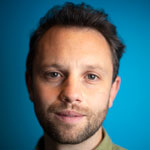Kevin Stark
Kevin Stark (MSJ16)
Science Reporter at KQED

During his time at Medill, Kevin Stark (MSJ16) spent six weeks studying melting glaciers in the Mongolian Altai Mountains, which he describes as a “once-in-a-career opportunity.” The trip resulted in him publishing two major magazine features. Stark now works as a science reporter for KQED public radio’s climate change unit in San Francisco.
Tell us about your career path.
I started working in journalism in the Pacific Northwest at my college newspaper and as an intern at Willamette Week in Portland, Oregon. Later, I became a lead reporter for the San Francisco Public Press, where I covered city politics and labor. In this role, I started reporting on the environment and climate change. I led a project looking at how sea-level rise would affect the Bay Area’s largest new mega-developments—from the Warriors' arena to Facebook’s headquarters.
This work launched me into the graduate program at Medill and helped me secure a Comer Scholarship, which Medill offers for students who demonstrate a commitment to covering environmental issues.
After graduating, I stayed in Chicago and produced environmental justice and climate change features for outlets like Pacific Standard Magazine, WBEZ’s Curious City, NPR’s Latino USA and Reveal with the Center for Investigative reporting. I also covered the clean energy transition in Illinois as a senior reporter for the Energy News Network. Since 2019, I’ve worked as a science reporter at KQED.
What are your main responsibilities at KQED?
I cover earthquakes, energy, politics and the environment broadly. I report stories for online and broadcast—our local audience is about 2.5 million people—and I often file nationally for NPR and for other media partners. I have covered youth-led climate protests; COVID-19, the worst pandemic in a century; scorching heat waves; energy blackouts; and several of the largest wildfires in California history. I’m a member of KQED’s climate change unit.
How has your Medill training helped you in your career?
At Medill, I learned key technical skills—web design, audio engineering and more—to function at a high-level in broadcast and digital journalism. I also learned how to craft a public records request, analyze data and chase investigative scoops.
What is a class or experience that sticks out in your mind?
In my final quarter at Medill, I spent six-weeks embedded with researchers studying melting glaciers in the Mongolian Altai. I met with scientists from the University of Maine who study abrupt climate change of the past for what it can tell us about future warming. We walked the length of a modern-day glacial field in the Bayan-Ölgii Province. The scientists collected rock samples and drone imagery, which they used to develop a map of the glacier’s retreat. I published two major magazine features from this reporting trip about how scientists are dating the demise of the last major Ice Age and finding a precise age for Mongolian petroglyphs. This was a once-in-a-career opportunity to dive deep into a story, a place and a very technical research area. And it was one-heck-of-a fun experience.
How has the Medill network helped you in your career?
Several professors such as Kari Lydersen, Bill Healy, Darnell Little and Abigail Foerstner provided mentorship, guidance and connections in the industry. They all also quickly became friends. As part of the Comer Scholarship, I met dozens of climate change researchers who are great sources for me today.

